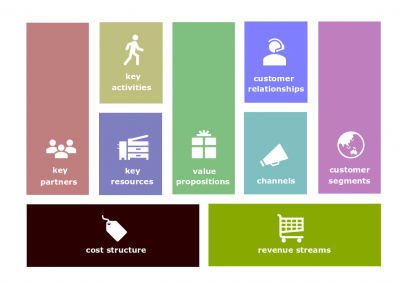Difference between revisions of "Business Model Canvas"
(Created page with "400px|thumb|right|[[Business Model Canvas]]Business Model Canvas (hereinafter, the ''Canvas'') is ''a strategic management template for...") |
(→Related coursework) |
||
| Line 4: | Line 4: | ||
A business model is a dynamic document that describes how your company creates, delivers and captures value. The 9 Business Model Canvas Building Blocks (Source: Business Model Generation): (1) [[customer segment]]s, (2) [[value proposition]]s, (3) [[channel]]s, (4) [[customer relationships]], (5) [[key resource]]s, (6) [[key activity|key activiti]]es, (7) [[key partnership]]s, and two summary blocks, (8) [[revenue stream]]s and (9) [[cost structure]]. | A business model is a dynamic document that describes how your company creates, delivers and captures value. The 9 Business Model Canvas Building Blocks (Source: Business Model Generation): (1) [[customer segment]]s, (2) [[value proposition]]s, (3) [[channel]]s, (4) [[customer relationships]], (5) [[key resource]]s, (6) [[key activity|key activiti]]es, (7) [[key partnership]]s, and two summary blocks, (8) [[revenue stream]]s and (9) [[cost structure]]. | ||
| − | ==Related | + | ==Related lectures== |
*[[Business Modeling Quarter]]. | *[[Business Modeling Quarter]]. | ||
[[Category: Septem Artes Administrativi]][[Category: Articles]] | [[Category: Septem Artes Administrativi]][[Category: Articles]] | ||
Revision as of 12:31, 4 January 2019
Business Model Canvas (hereinafter, the Canvas) is a strategic management template for developing new or documenting existing business models. It is a visual chart with elements describing a firm's value proposition, infrastructure, customers, and finances. It assists firms in aligning their activities by illustrating potential trade-offs. (Source: Wikipedia)
Blocks
A business model is a dynamic document that describes how your company creates, delivers and captures value. The 9 Business Model Canvas Building Blocks (Source: Business Model Generation): (1) customer segments, (2) value propositions, (3) channels, (4) customer relationships, (5) key resources, (6) key activities, (7) key partnerships, and two summary blocks, (8) revenue streams and (9) cost structure.
